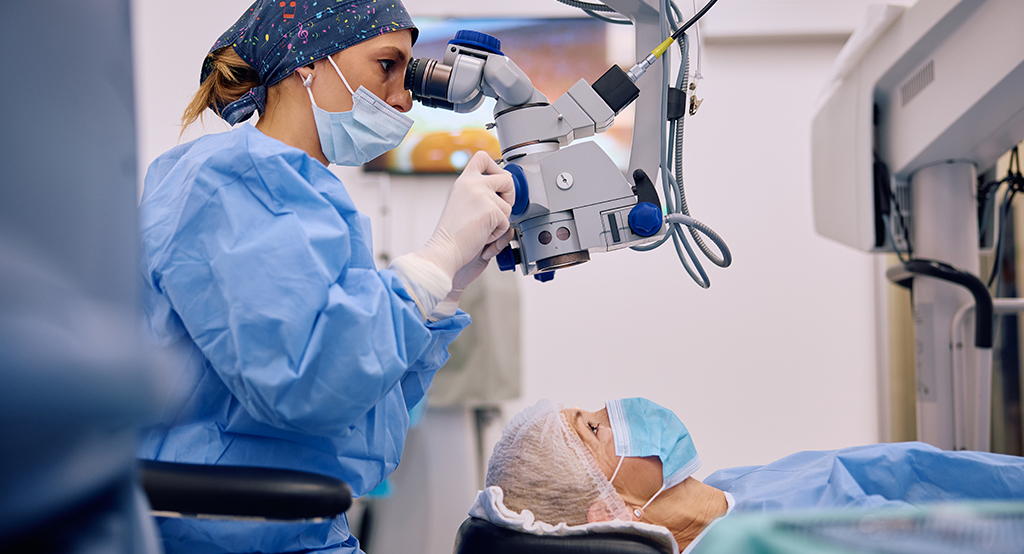If you’ve been told you need cataract surgery, chances are you’ve already come across a few buzzwords—femtosecond lasers, foldable lenses, and maybe even something called MICS. That last one stands for Microincision Cataract Surgery, and it’s a technique that’s gaining serious traction in operating theatres worldwide. But what is it really? And does going smaller with the incision actually make things better for you?
This article dives into the world of minimally invasive cataract surgery, exploring the science behind it, how it differs from traditional methods, and whether it truly lives up to the hype. So if you’re weighing up your options—or just want to be better informed about this crucial eye procedure—read on. Let’s break it all down together.
What Is Microincision Cataract Surgery (MICS)?
Let’s start with the basics. Traditional cataract surgery—still widely used and very successful—involves making an incision of around 2.75 to 3.2 mm in the cornea to remove the cloudy lens and replace it with an intraocular lens (IOL). Microincision Cataract Surgery, however, aims to do the same job through a much smaller incision—typically less than 2 mm.
That might not sound like a huge difference, but in the world of eye surgery, even fractions of a millimetre matter. These smaller incisions require specially designed surgical instruments and ultra-foldable IOLs that can be inserted through the narrow opening and then unfolded inside the eye.
By reducing the incision size, surgeons hope to cause less trauma to the eye, promote faster healing, minimise inflammation, and improve visual outcomes. But is that what actually happens? Let’s look closer.
How MICS Differs from Standard Phacoemulsification
You might be wondering—aren’t all cataract surgeries “minimally invasive”? And in a way, yes. Modern cataract surgery already relies on small incisions and ultrasonic energy to break up the cataract (a process called phacoemulsification). But MICS takes that principle even further.
While standard phaco uses a coaxial approach (where irrigation, aspiration, and ultrasound energy pass through a single sleeve), MICS typically uses a bimanual technique. This means the surgeon works with two micro-instruments: one for phacoemulsification and one for irrigation/aspiration. It allows for even smaller incisions—often as tiny as 1.8 mm.
These reduced diameters demand not just more delicate manoeuvring but also advanced fluidics and highly skilled surgical hands. It’s not necessarily the right fit for every surgeon or every patient, but in experienced hands, the benefits can be remarkable.

Endothelial Cell Loss: Why It Matters
One of the key concerns during any eye surgery is preserving the health of your corneal endothelium—the single layer of cells on the inner surface of the cornea that keeps it clear. These cells don’t regenerate, so if too many are lost during surgery, you could end up with corneal swelling or even long-term vision issues.
Here’s where MICS might offer a real advantage. Research has shown that smaller incisions can reduce turbulence in the anterior chamber and lower the energy required for phacoemulsification. Both of these factors contribute to better endothelial cell preservation.
Studies comparing MICS with standard coaxial surgery have shown slightly better endothelial cell counts post-op with the microincision approach. While the difference might not always be drastic, in high-risk patients—like those with Fuchs’ dystrophy or pre-existing endothelial dysfunction—it can be clinically meaningful.
Faster Wound Healing and Lower Risk of Complications
When you make a smaller incision, it naturally causes less disruption to the ocular tissue. That means the wound is more likely to be self-sealing and stable, with a reduced chance of leakage or infection.
Microincision wounds also induce less astigmatism. Why? Because a smaller entry point disturbs the corneal shape less, meaning you’re more likely to maintain a smooth, regular curvature. That translates into clearer post-operative vision and often a quicker return to sharp eyesight.
In fact, some studies suggest that patients undergoing MICS experience less post-op inflammation, faster wound healing, and are less likely to need sutures or topical steroids for long. This contributes to a smoother, more comfortable recovery journey.
Recovery Time: What Can You Expect?
Everyone wants to know—how long until I can see clearly again? With MICS, many patients report sharper vision within the first few days. That’s not to say traditional surgery is slow—it’s actually very quick by medical standards—but the smaller incision in MICS might give it a slight edge.
Since there’s less induced astigmatism and trauma, there’s often less fluctuation in vision during the healing phase. You’re less likely to experience those ups and downs in clarity that some people notice in the first week or two post-op.
Of course, recovery still depends on a lot of factors—your age, your overall eye health, how dense the cataract was, and how smoothly the operation went. But all things being equal, MICS tends to offer a speedier visual recovery for many patients.

Is MICS Always the Best Choice?
Here’s where things get a bit more nuanced. While Microincision Cataract Surgery (MICS) brings several advantages to the table, it’s not a one-size-fits-all solution. Some cataracts, especially those that are very advanced or unusually dense, require more energy and manipulation to break apart. In these cases, sticking to a sub-2 mm incision may limit the surgeon’s access or efficiency. To avoid potential complications or prolonging the operation, a slightly larger incision might be the safer and more practical choice. It’s a matter of balancing minimal invasiveness with surgical effectiveness.
Anatomical variations in the eye can also influence whether MICS is the most suitable approach. Eyes with deep-set sockets, narrow anterior chambers, or other structural challenges may present logistical hurdles that make microincision techniques less favourable. The tighter working space of bimanual MICS demands exceptional control and visibility, so in some cases, a coaxial technique with a standard incision provides better access and a smoother workflow. The surgeon must evaluate not only the cataract itself, but the overall ocular environment before committing to a specific method.
It’s also important to recognise that MICS has a learning curve. Not all ophthalmic surgeons are trained in the bimanual approach, which requires a different set of hand movements and fluidic control than traditional coaxial phacoemulsification. Even among those with the skills, many opt to use MICS selectively—reserving it for patients with appropriate cataract types and eye anatomy. This isn’t a sign of reluctance, but rather of responsible, case-by-case decision-making. Ultimately, it’s not about declaring one technique superior, but about choosing the right tool for the right job.
That said, when MICS is chosen appropriately and performed by an experienced surgeon, the outcomes are genuinely impressive. Patients often enjoy quicker visual recovery, less post-operative discomfort, and reduced dependence on corrective eyewear. The rates of complications such as induced astigmatism or wound leakage tend to be lower, and the overall satisfaction levels are high. For many patients, especially those seeking a fast return to daily life, MICS delivers exactly what they’re looking for—a safe, refined, and effective route to better vision.
Lens Technology and the Role of Incision Size
One of the challenges with MICS is IOL insertion. Smaller incisions demand thinner, more flexible lenses. Luckily, advances in IOL design have kept pace with surgical techniques. There are now ultra-foldable lenses that can be injected through sub-2 mm openings and still deliver premium visual performance.
Some surgeons use a microincision for phaco but slightly enlarge the wound for lens insertion—technically not “true MICS” but still a hybrid approach that reaps some of the benefits. Either way, incision size plays a crucial role in IOL positioning, stability, and long-term refractive outcomes.
Whether you’re opting for a monofocal lens or a premium multifocal or toric option, MICS can accommodate a wide range of IOL choices—as long as the right lens and injector system are used.
The Learning Curve: A Note for Patients
As a patient, you might not be too concerned about the technical details of how your surgeon performs the operation—but they matter more than you might think. MICS is a more technically demanding procedure than standard phaco, particularly because of the need for two-handed manoeuvring and the precise control of fluid dynamics.
This means the outcomes heavily depend on surgeon experience. A surgeon well-versed in MICS can deliver phenomenal results. But if your surgeon is more comfortable with standard techniques and has a strong track record, it might make more sense to go with what they know best.
It’s always a good idea to ask your surgeon about their experience with different techniques and what they recommend for your specific case. Trust, communication, and experience are what really drive good outcomes.
What Does the Research Say?
There’s been a growing body of literature comparing MICS to traditional coaxial phaco. While individual studies vary in design and quality, the general consensus is that MICS offers similar or slightly better outcomes in terms of:
- Lower induced astigmatism
- Faster visual rehabilitation
- Better endothelial cell preservation
- Less post-op inflammation
- Reduced need for sutures
Meta-analyses and randomised trials have shown statistically significant—but modest—advantages in these areas. However, most researchers also stress that the real-world benefit depends heavily on patient selection and surgeon expertise.
So it’s not a magic bullet, but it is a compelling option—especially for patients who value rapid recovery and minimal post-op discomfort.
Real Patient Experiences: What People Are Saying
Many patients who’ve undergone MICS describe the experience as remarkably smooth. Some report regaining functional vision within 24 to 48 hours, with very little discomfort. Others appreciate the reduced need for eye drops and medications in the days following surgery.
Of course, every experience is different. Some patients have just as excellent outcomes with traditional incisions, particularly when they were operated on by a highly experienced surgeon using the best available technology. But the idea that you can have cataract surgery with such tiny incisions—and be out and about in a matter of hours—is understandably appealing.

MICS and the Future of Cataract Surgery
Looking ahead, Microincision Cataract Surgery (MICS) appears poised to take on a more prominent role in modern ophthalmology. As surgical instruments become more refined and lens materials grow increasingly flexible and biocompatible, what was once considered a highly specialised technique is quickly becoming part of everyday surgical practice. Sub-2 mm incisions are no longer viewed as a risky or overly ambitious approach—they’re being embraced by more surgeons as a viable path to consistent, high-quality outcomes. With each passing year, more training centres and residency programmes are incorporating MICS into their standard curricula, reflecting the broader acceptance of this minimally invasive method.
Another exciting area of growth lies in integrating MICS with complementary technologies. Femtosecond laser-assisted cataract surgery, for instance, offers unprecedented precision when it comes to creating corneal incisions and fragmenting the lens. When paired with MICS, it may reduce the need for ultrasonic energy even further, preserving delicate intraocular structures. Likewise, intraoperative aberrometry—real-time measurement of refractive error during surgery—adds a layer of customisation that enables more precise IOL selection and placement. This convergence of microincision techniques with cutting-edge tools suggests that we’re moving toward an era of cataract surgery that is not only safer and faster, but also highly individualised.
Patient expectations are also shaping the future of cataract surgery. Today’s cataract patients are often younger, more active, and more visually demanding than previous generations. They want fast recovery, reduced dependence on glasses, and outcomes that support their lifestyle. MICS, with its smaller incisions and lower risk of surgically induced astigmatism, aligns well with these demands. As more patients research their options and ask questions about incision size, visual recovery, and lens types, clinics that offer advanced techniques like MICS are likely to be seen as more progressive and patient-focused.
With ongoing research, technological refinement, and widespread adoption, it’s entirely plausible that MICS will become the new gold standard for cataract surgery. It’s not just about making smaller cuts—it’s about rethinking the whole surgical experience for both patient and surgeon. From reduced post-operative care to better long-term vision outcomes, the shift towards microincision techniques reflects a broader trend in medicine: do more, harm less, and personalise everything. The trajectory is clear—MICS isn’t just the future of cataract surgery; it may well define it.
Final Thoughts
So—smaller incisions, better outcomes? The answer, in many cases, is yes. Microincision Cataract Surgery offers clear benefits in terms of wound stability, endothelial safety, and quicker recovery. But like all medical advancements, it’s not about replacing one technique with another across the board. It’s about choice, customisation, and doing what’s best for each individual patient.
If you’re considering cataract surgery, talk to your ophthalmologist about all your options—including MICS. Ask about their experience with the technique and whether it could offer you any particular advantages. With the right match of skill, technology, and patient profile, this ultra-precise approach might just be the key to clearer, faster, and more comfortable vision restoration.
If you would like to learn more about the best options to treat your cataracts, you can contact us at the London Cataract Centre to book a consultation with one of our expert private cataract surgeons.
References
- Alió, J.L., Abdou, A.A. and Abdelghany, A.A., 2014. Microincision cataract surgery: a review. Eye and Vision, 1(1), pp.1–10.
- Zhu, X., He, W., Zhang, Y. and Lu, Y., 2015. Comparison of endothelial cell loss after phacoemulsification in hard nucleus cataract: 1.8 mm microincision versus 2.75 mm coaxial incision. Journal of Cataract and Refractive Surgery, 41(1), pp.90–95. https://doi.org/10.1016/j.jcrs.2014.05.044
- Vasavada, A.R., Raj, S.M. and Nanavaty, M.A., 2007. Safety and efficacy of a new microcoaxial phacoemulsification system: randomized clinical trial. Journal of Cataract and Refractive Surgery, 33(9), pp.1557–1561.
- Cavallini, G.M., Ducoli, P., Forlini, M. and Campi, L., 2012. Influence of incision size on surgically induced astigmatism after cataract surgery with the same phaco tip: 2.2 versus 1.8 mm. Journal of Cataract and Refractive Surgery, 38(6), pp.1036–1042.
- Lundström, M., Dickman, M., Henry, Y., Manning, S., Rosen, P. and Tassignon, M.J., 2013. Risk factors for refractive error after cataract surgery: analysis of 62,624 eyes in the European Registry of Quality Outcomes for Cataract and Refractive Surgery. Journal of Cataract and Refractive Surgery, 39(5), pp.739–746.

